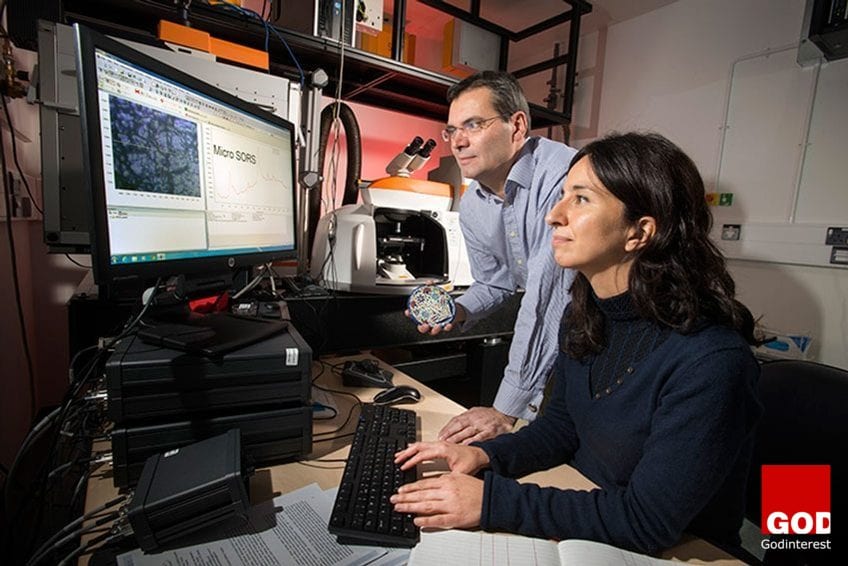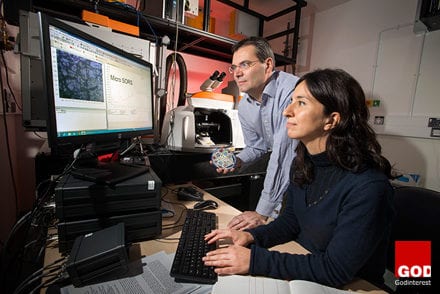We normally focus on what we do not have, as opposed to what we do have. We focus on how big our obstacles are, and how bad the economy is etc. “I don’t have the connections… I’ve got this problem, but I don’t have anybody to help me… I’ve got this dream, but I don’t have the resources”. Yet here is the truth, everything you need to fulfill your destiny is within reach. God will always use something that’s close to you. It may not look extraordinary, but you have what it takes to fulfill your destiny.
Like when David faced the giant, Goliath. All he had was a slingshot and five stones. It looked ordinary. He could have thought, “I’m not going to face Goliath. That would be foolish. I don’t have a chance”. But David knew that with God on his side, those ordinary stones would be exactly what he needed. Sure enough, David defeated Goliath with what he had and made history.
Today, remember victory isn’t about what you have, it’s about God’s anointing on what you have. With God on your side, all things are possible! Focus on Him and what He has given you. God can do great things in your life because He has placed extraordinary things in you, use them today.
“So David triumphed over the Philistine with a sling and a stone; without a sword in his hand he struck down the Philistine and killed him.” (1 Samuel 17:50, NIV).
Let’s Pray
Yahweh, thank You for equipping me for success and victory in this life. Help me to clearly see the opportunities, connections and resources You have ordained for me. I trust that with You, all things are possible. In Christ’ name, Amen!
The Kingdom OF God is Like…
While at seminary school I was told “you are what you’re becoming”. And in the new testament we are reminded that we are kingdom people now. So what’s God’s kingdom like? In God’s kingdom, when you give, it comes back to you pressed down, shaken together and running over. In God’s kingdom, you can have peace and prosperity in your spirit, soul and body, no matter what’s happening around you. If the economy crashes, God’s kingdom is still strong. If the housing market goes down, God’s kingdom is still strong. If petrol prices rise, God’s kingdom is still strong. Hallelujah!
Scripture says that we are receiving a kingdom that cannot be shaken! The kingdom is simply God’s system, principles and promises. It’s His way of doing things. The Bible tells us over and over what God’s kingdom on earth is like, that His kingdom is righteousness, peace and joy in the Holy Spirit.
Today, be thankful for the system of God’s kingdom which orders the Christian’s life. Thank Him for His system of blessing that cannot be shaken by the drama of this world. As you keep an attitude of gratitude and walk in God’s kingdom ways, you’ll experience His hand of blessing all your days!
“Therefore, since we are receiving a kingdom that cannot be shaken, let us be thankful, and so worship God acceptably with reverence and awe.” (Hebrews 12:28, NIV)
Let’s Pray
Yahweh, thank You for Your kingdom, not just to come but now! Father, thank You for Your system that blesses my life. God, I open my heart to You. Please show me Your ways so that I can be a kingdom person now, and walk-in Your kingdom way’s all the days of my life, in Christ’s Name! Amen.
God’s Anointing Is On You
We normally focus on what we don’t have, as opposed to what we do have. We focus on how big our obstacles are, and how bad the economy is etc. “I don’t have the connections. I’ve got this problem, but I don’t have anybody to help me. I’ve got this dream, but I don’t have the resources.” Here is the truth: everything you need to fulfill your destiny is within reach. God will always use something that’s close to you. It may not look extraordinary, but you have what it takes to fulfill your destiny.
Like when David faced the giant, Goliath, all he had was a slingshot and five stones. It looked ordinary. He could have thought, “I’m not going to face Goliath. That would be foolish. I don’t have a chance.” No, David knew that with God on his side, those ordinary stones would be exactly what he needed. Sure enough, David defeated Goliath with what he had and made history.
Today, remember, victory isn’t about what you have, it’s about God’s anointing on what you have. With God on your side, all things are possible! Focus on Him and what He has given you. God can do great things in your life because He has placed extraordinary things in you, use them today.
“So David triumphed over the Philistine with a sling and a tstone; without a sword in his hand he struck down the Philistine and killed him.” (1 Samuel 17:50, NIV)
Let’s Pray
Yahweh, thank You for equipping me for success and victory in this life. Help me to clearly see the opportunities, connections and resources You have ordained for me. I trust that with You, all things are possible, in Christ’ name! Amen.
It’s All About Your Perspective
After one of the biggest revivals in Preston and many people giving their heart to the Lord, I find myself focused on what’s wrong in life, what I don’t have, and how big my obstacles are. If we’re not careful, we’ll lose sight of all the good things God has done. We’ll take for granted our family, friends, health and the opportunities God has blessed us with. We’ll get so busy and stressed out that we won’t appreciate our blessings. What’s happened? Our perspective has gotten off track.
It’s all about how we see a situation. There’s power in your perspective because you draw into your life what you constantly meditate on. Business may be slow. The economy may be down. The wrong perspective is, “I’ll never make it. It’s just too much.” The right perspective is, “God is supplying all of my needs. He said He would prosper me even in a desert.”
Today, I encourage you to evaluate your perspective. Choose to lift your eyes to God no matter what is happening in your circumstances. Remember, as you set your perspective in the right direction, your life will follow. When you keep an attitude of faith and expectancy, you open the door for His blessings in every area of your life!
“I will bless the Lord at all times; His praise shall continually be in my mouth.” (Psalm 34:1, NKJV)
Let’s Pray
Yahweh, I choose to bless You at all times. I declare that You are faithful! Father, I lift my eyes to You because You are the source of my help. Please give me the right perspective in my thoughts and my life. God, I need more strength and joy today. Thank You for leading and guiding me, in Jesus’ name! Amen.
Why Worry?
With infection rates going up, our children about to head back to school, and the economy the lowest it’s ever been, it’s easy to worry. What are you worrying about today? To worry means to allow something to revolve in your mind over and over again until it stresses you out. God doesn’t want you to live worried or anxious about anything. He knows that worry steals your peace and joy. It affects every area of your life negatively. Have you heard the saying, “Don’t worry yourself sick?” That’s because worrying affects your physical and mental body. It even affects your sleep.
The Bible says you won’t ever gain anything by worrying; in fact, you’ll lose precious moments that you can never get back again. The good news is that God has promised that you can have victory over worry. It starts by making the choice to trust in Him. When you cast your cares on Him, He will give you His peace, which will eradicate your worry. Hallelujah!
Today, why not put an end to worry in your life. Choose to feed your faith and fill your mind with God’s promises of peace. As you focus on God’s Word, and spend time in conversation with Him, He will drive out worry and fill your heart with faith and expectancy, and you will overcome in every area of your life!
“Can any one of you by worrying add a single hour to your life?” (Matthew 6:27, NIV
Let’s Pray Yahweh, today I give You permission to put an end to worry in my life. Father, I have decided to feed my faith by studying Your promises, and declaring Your Word over my life. God, help me to totally trust in You today and every day, in Christ’s Name! Amen.
What Is the Kingdom of God?
With all that’s going on in this world, have you been wondering about God’s kingdom? What it is, or where it is? The Bible says the kingdom of God is in the here and now, and thank God, we have a kingdom that cannot be shaken! The kingdom is simply God’s system and His throne. It’s His way of doing things. The Bible tells us that His kingdom is righteousness, peace and joy in the Holy Spirit. Hallelujah!
In God’s kingdom, when you give, it shall be given back to you, pressed down, shaken together and running over, this is not only talking about money. In God’s kingdom, you can have an abundance of peace and prosperity in your spirit, mind and body, no matter what’s happening around you. And just like the verse says, His kingdom cannot be shaken! That means, if the stock market goes down, God’s kingdom is still strong. If the housing market goes down, God’s kingdom is still strong. If gas prices go up, God’s kingdom is still strong!
Today, you can live in God’s kingdom that cannot be shaken no matter what’s happening here on earth. Begin to thank God today for His kingdom. Thank Him for His system of blessing in every area of your life. As you obey His Word and worship Him with a grateful attitude, you’ll embrace His kingdom and walk in the abundant life He has for you!
“Therefore, since we are receiving a kingdom that cannot be shaken, let us be thankful, and so worship God acceptably with reverence and awe.”
(Hebrews 12:28, NIV)
Pray With Me
Yahweh, thank You for Your kingdom of peace that lives amongst us. Father, thank You for Your system of blessing in my life. I praise You oh God for Your kingdom that cannot be shaken by the things of this earth, the economy, the prime minister or manifesto, biological games, or people with demonic intent. God, I open my heart to You and ask that You reveal Your truth to me, so that I can live in Your ways all the days of my life, in Christ’s Name! Amen.
BPS World Research Highlights Challenges Facing Employers in 2017 Following Brexit
Global resourcing specialist BPS World has warned that one of the main challenges facing employers in the UK in 2017 will be the impact of Brexit on the ability to attract talent, particularly in the high-value digital, technical and engineering industries where recruiters are already struggling with severe skills shortages. This follows the publication by BPS World, of: “Brexit: What the World is Saying” which, for the first time, researched the global impact of Brexit and how other countries believe it will impact on skills.
Simon Conington, Founder of BPS World, has urged the government to ensure that the UK continues to have access to skilled professional from Europe, particularly in the sectors where there are already skills shortages, or face a sharp decline in the UK’s ability to compete.
Although the UK will not be leaving the EU until 2019 we can expect an announcement this year on the shape of Brexit and what it will mean in practice. Under so-called ‘hard-Brexit’ freedom of movement would be restricted and it would be as difficult for talent to be recruited from France as from the US. It is this that alarms those at the sharp end of skills shortages, such as BPS World. Recruits themselves are already showing signs of being aware of these new competitive forces: research revealed that almost half (48 per cent) of UK jobseekers were more concerned about finding a job than before the referendum.
Last year BPS World spoke to business leaders, representative bodies and professionals in the recruitment and retention sectors in Europe, India, Australia and the USA. The research focussed on the sectors most affected by skills shortages in the UK and overseas. It is in these sectors that the impact of Brexit and any restrictions or changes to work permits, is likely to be most keenly felt.
One of those they spoke to was Marco Dadomo, from the Verein Deutscher Ingenieure (VDI, Association of German Engineers) in Düsseldorf: “As we know, Britain has already problems finding enough specialists in this sector. Brexit will make it less attractive for international experts to work in Britain for a British company. We have also heard that quite a lot of UK experts of different sectors plan to leave Britain when Brexit will be implemented.”
Simon Conington, Founder of BPS World argued;
“2017 is going to be a pivotal year for the UK economy. The decisions the government makes now on the implementation of Brexit will affect our ability to attract the talent we need to grow. The impact will be felt immediately as talent will not come to the UK if they know they will have to leave within two years. We urge the government to continue to ensure we have access to skilled people, particularly in sectors where we’re already struggling to find the talent we need.”
Kevin Green, Chief Executive of the REC welcomed the report:
“This review of the international community’s fears and needs following the EU referendum contains warnings about the challenges employers could face in the future. The prospect of skill and talent shortages intensifying in higher-end sectors is a huge concern. The government must ensure that any changes to immigration policy as a result of the EU negotiations reflect immediate labour market needs so that businesses can continue to grow.”
Brexit: What the World is Saying is available free to download from www.bps-world.com
Notes to Editors
BPS World are global resourcing experts who work across a number of sectors, specialising in technology, marketing and engineering.
For further information:
Julia Barton
Onyx
E: julia@onyxcomms.com
T: + 44 20 7048 2700
3 Tips for Dealing with a Manipulative Project Co-Worker
Are you stuck working with a project manager who is manipulative and dishonest? If you are, you’re not alone!
Today’s workplace is a cut-throat environment with everyone trying to get ahead in some way, shape, or form. It’s no surprise that there are malicious, sneaky project managers who will do anything to get a leg up to succeed or survive, even if it means throwing you under the bus. Like a clever politician, these project managers keep their desires hidden, but underneath a friendly and charming exterior is a highly destructive individual whose goals are power and control. Pretending to pursue the greater good, he or she adopts the mantra of “company first” with a fervency that inspires admiration and respect, and most people accept his or hers claims of a selfless pursuit of noble causes.
Regardless of your industry, profession, experience level or company, these manipulative people exist and, if given the right opportunity, they can ruin your reputation and career prospects. They’ll tell you that the entire team hates you, thinks you’re arrogant, stupid, or incompetent, and attempt to manipulate you into believing that their opinions are objective facts. A study published in the Journal of Applied Psychology called it “social undermining” and “bottom line mentality.”
“According to a recent survey, roughly 90% of folks who read this post are presently working with at least one person who, mentally, would be described as a manipulator”.
Proving yourself in a new organization is hard enough. When someone manipulates and lies about you, it can hurt your relationships, your reputation, and your career. Luckily, Project Journal has 3 tips for effectively dealing with this workplace danger.
1. Don’t Ignore Your Gut
I should’ve seen it coming. Unfortunately, there isn’t a clear-cut answer to the question “Friend or foe.” If you find yourself putting up your guard around a co-worker, you might wonder if you’re imagining things and being paranoid? Well, maybe you are, but under no circumstances should you ignore your feeling. From experience, this is often the very first sign of trouble. Weak leaders sometimes resort to emotional deceit as a weapon for getting things done. Try to consider facts objectively. Manipulation is normally felt, rather than heard or seen, so you must listen to your gut.
What makes you mistrust this person? Do they constantly gossip? If so, be careful as those who gossip to you, will probably be doing the same about you too and like Mom always said, “If you don’t have anything nice to say, don’t say anything at all.” Plus, you don’t want to get caught up in the drama when people find out about this control freak’s gossiping.
Trust that you will be thrown under the bus when “stuff” hits the fan. If you’re still unsure, you should run their behaviour by objective people you trust. As trust is built on the foundations of a good relationship, instead of basing trust on someone’s words, observe their deeds.
2. Dealing with a Bad Apple
There’s a lot to be said for the old saying, “One bad apple can spoil the whole barrel.” Not only is that true for fruit, but it holds a lot of merit in the work environment. Rude behavior is contagious. Toxic manipulative employees have an unhealthy ripple effect that harms co-workers, managers, and subordinates alike. They lack positive personality traits, such as genuine concern for others, a generous and understanding nature, a desire to teach and encourage, a desire to have straightforward dealings with others. They dwell in a very dark place lit only by their own ambition.
“It takes just one malicious employee among the ranks to wreak havoc on your team’s culture.”
Healthy human interactions are not dominated by manipulation. If you feel you can’t trust them, don’t. Manipulators do not communicate openly. Instead, they resort to flattery or play the victim to gain your trust and sympathy. Through artful, indirect and devious methods, they influence and control others and have a fair amount of social support, most likely because no one wants to be on their bad side. But that doesn’t mean their behavior isn’t harmful.
Your priority in this situation must be to protect your professional standing. Begin documenting every instance of destructive behavior and take it to a higher authority. When a co-worker starts manipulating you and ignoring the behavior doesn’t work, distance yourself, if possible and keep all correspondences. When colleagues try to sabotage you, they might tell you lies to cause you to make mistakes. The more you cover yourself, the less you have to worry about. Change your passwords, shut down your computer when you leave your desk, and keep sensitive documents under lock and key. Remember to “choose your words carefully when sending emails so that things you write can’t come back to bite you. Unfortunately, if you lose your cool, you will be in danger of looking undignified.”
“When you know what a man wants you know who he is, and how to move him.”
’- George R.R. Martin, A Storm of Swords
It can be tempting to excuse the antagonistic worker who seems zealous about his job, but clearly, those employees may be undermining the entire workforce. Being direct lets the other person know you’re aware of their manipulative behavior, and in some cases, that may be enough to nip it in the bud. If you stay out of their world of negativity, you will be a much more difficult target for their manipulation.
3. Counteracting Sabotage
Manipulators are blind to the serious defects in their character, but keenly aware of the slightest weakness or imperfection in others. They are judgmental, suspicious, demanding and calculating, all negative personality characteristics. Even their outward charm is cold and calculated. Before you can deal with the situation, you need to understand the impact.
Is it a small lie with little effect? Is it a big lie that requires damage control or even legal action? Consider how others might view the situation. Although it may be difficult, the best choice might be simply to move on as the people who make it in the long-term are the ones who are honest, hardworking and able to maintain their professionalism.
“According to a recent Wall Street Journal article, workplace sabotage is on the rise in this difficult economy.”
If you choose to directly address the situation. It is critical to use neutral language and tone of voice. Do not stoop to their level, it is important to keep your integrity. Consider having witnesses to your conversation so it’s not your word against theirs.
Your final action can be accepting an apology and moving on, or it can be reporting the lie to a higher authority. In extreme cases, it can be making a formal complaint or hiring an attorney. It’s smart to search for job postings, even when you have no intention to quit. Obviously, you don’t want to let one bad apple lead to your resignation but, if nothing else, knowing you have options can help you feel more empowered and in control of the situation.
Other signs sabotage may be in the works: You don’t receive a promotion or responsibilities you logically should have gotten; cold or averse behavior from management that is (seemingly) out of nowhere; sudden and unexplained alienation by individual co-workers or even entire cliques; or unwarranted and continuous kind behavior from someone that was formerly aloof, ambivalent or even aggressive.
Manipulative behavior is widespread, but fortunately, it doesn’t exist everywhere. Do you have manipulative co-workers? How do you dodge their requests and still manage to pave a successful career path? Tell us what you think?
Love this article? Share it with your friends on Facebook
How Technology Has Changed Procurement in the Last 10 Years

Over the past decade business procurement has experienced rapid technological upheaval that, in the main, has made life easier for everyone involved.
The first ever Global Procurement Technology Summit was held in March 2016. It shows the emphasis procurement is now putting on understanding and utilising new technologies, and that it’s clearly a huge talking point for professionals across the world.
Looking in greater detail: which technology has been responsible and what has the effect been on procurement and buying professionals?
1. More informed decisions are being made
The digitalisation of procurement processes and integration of data-sharing across buyer behaviour, ratings and history of purchases over extended periods of time, has made for smarter and more informed decisions.
Despite the greater insight into decision-making, a study of US procurement professionals still revealed accurate forecasting to be the biggest challenge, something that’s possibly down to the rise in budget responsibilities over the last ten years.
The Coupa ‘Top 5: Constants and Change in Cloud Procurement’ report revealed that in 2003, budgets were reported as an average of $31m, compared to $100m in 2013.
2. Response times have drastically reduced
Procurement solutions are now quicker and easier than ever thanks to new marketplace technologies.
Buyers can take advantage of online purchasing possibilities, using websites like Amazon to source, purchase and arrange delivery of items.
The speed of procurement reflects the new speed in which consumerism moves ’’ the integration of digital mediums with online shopping has made the process of deliberation through to transaction much easier, a trend which has been reflected in the world of procurement.
3. Integration has brought its own problems
Technological integration has created many positives for procurement, but it’s also created challenges.
Millennials will make up 40% of the workforce by 2020, which is great for improving current procurement solutions as younger generations have higher expectations for technology and are early adapters.
However, the average age of procurement professionals in the UK is currently 44 – much older than the next generation of workers, who fully understand the capabilities of technology, and who will be easier to train and able to work with increased speed and accuracy.
The gap will close in the coming years, but procurement faces a struggle as older workers need to ensure their skills are relevant to the changing world around them.
Additionally, Hays’ ‘Procurement Salary Guide’ revealed that demand for procurement professionals has increased at all levels within the public sector, pushing salaries up. This demand is the result of a squeeze on public finances and attempts to cut costs following the slowdown in the economy.
4, Technology and the future of procurement
To conclude, technology is clearly a powerful enabler that’s here to stay. Plenty of companies are now seeing the importance of procurement technology as a means to improve their bottom lines, which was reflected in the inaugural Global Procurement Technology Summit earlier this year.
Integration of contract management, risk management and supplier lifecycle systems through investment in improved systems with added capabilities, has ensured more accurate sourcing is possible and due to the skills involved in running these systems, has driven salaries up.
Sophia Chapman is a guest contributor from Portfolio Procurement, expert recruiters in the compensation, benefit and reward sector.
Has Nigeria Become the World’s Junk Yard of Abandoned and Failed Mega Projects worth Billions?
Dim1, N. U., Okorocha2, K. A., & Okoduwa3 V. O.
The Nigerian construction industry is mostly concerned with the development and provision of projects such as roads, bridges, railways, residential and commercial real estates, and the maintenance necessary for the socio-economic developments contributes immensely to the Nigerian economic growth (Bureau of Statistics, 2015). Butcher and demmers (2003) described projects as an idea which begins and ends by filling a need. However, a project fails when its idea ends without meeting the needs and expectations of its stakeholders.
Nigeria Has Become the World’s Junk – Yard of Abandoned and Failed Projects worth Billions of Naira!
Hanachor (2013), revealed that projects form part of the basis for assessing a country’s development. However, a damming report from the Abandoned Projects Audit Commission which was set up by the Ex-President Goodluck Jonathan in 2011 revealed that 11,886 federal government projects were abandoned in the past 40 years across Nigerian (Abimbola, 2012). This confirmed the assertion by Osemenan (1987) “that Nigeria has become the world’s junk –yard of abandoned and failed projects worth billions of naira”.
Abandoned projects including building and other civil engineering infrastructure development projects now litter the whole of Nigeria.
Physical projects do not only provide the means of making life more meaningful for members of the community where the projects are located, successful projects also result in empowerment and collective action towards self improvement (Hanachor, 2013).
This Issue of Abandonment Has Been Left Without Adequate Attention for Too Long, and Is Now Having a Multiplier Effect on the Construction Industry in Particular and the Nigeria’s National Economy as a Whole. (Kotngora, 1993)
PROJECT FAILURE
Project Failure might mean a different thing to different stakeholders. A project that seemed successful to one stakeholder may be a total failure to another (Toor and Ogunlana, 2008). Some stakeholders, more especially the project users and some private owners, think of failed projects as a situation where a completed building project collapsed, a situation where by a completed dam project stopped working after few days of completion, or a completed road project that broke down after few months of completion. Other experienced stakeholders, such as engineers and architects conform to the iron triangle by Atkinson (1999) which states that the most strategically important measures of project failure are “time overrun”, “cost overrun”, and “poor quality”.
Turner (1993) noted that a project fails when the project specifications are not delivered within budget and on time; the project fails to achieve its stated business purpose; the project did not meet the pre-stated objectives; the project fails to satisfy the needs of the project team and supporters; and the project fails to satisfy the need of the users and other stakeholders. Lim and Mohamed (1999) cited in Toor and Ogunlana (2009) clarified that there are two possible view points to project failure namely; the macro-level and the micro-level. They further explained that the macro view point reviews if the original objectives and concepts of the project was met. Usually the end users and the project beneficiaries are the ones looking at the project failure from the macro view point, where as the project design team, the consultants, contractors, and suppliers review projects from a micro view point focusing on time of delivery, budget, and poor quality.
In the early 1990s, the failure as well as the success of any project was determined by the project duration, monetary cost, and the performance of the project (Idrus, Sodangi, and Husin, 2011). Belout and Gauvrean (2004), also confirmed that the project management triangle based on schedule, cost, and technical performance is the most useful in determining the failure of a project. Moreover, a project is considered as an achievement of specific objectives, which involves series of activities and tasks which consume resources, are completed within specifications, and have a definite start and end time (Muns and Bjeirmi 1996, cited in Toor and Ogunlana, 2009). Reiss (1993) in his suggestion stated that a project is a human activity that achieves a clear objective against a time scale. Wright (1997) taking the view of clients, suggested that time and budget are the only two important parameters of a project which determines if a project is successful or failed. Nevertheless, many other writers such as Turner, Morris and Hough, wateridge, dewit, McCoy, Pinto and Slevin, saarinen and Ballantine all cited in Atkinson (1999), agreed that cost, time, and quality are all success as well as failure criteria of a project, and are not to be used exclusively.
FACTORS OF PROJECT FAILURE
Cookie-Davies (2002) stated the difference between the success criteria and the failure factors. He stated that failure factors are those which contributed towards the failure of a project while success criteria are the measures by which the failure of a project will be judged. The factors constituting the failure criteria are commonly referred to as the key performance indicators (KPIs).
Time and Cost Overrun
The time factor of project failure cannot be discussed without mentioning cost. This is because the time spent on construction projects has a cost attached to it. Al-Khali and Al-Ghafly, (1999); Aibinu and Jagboro, (2002) confirmed that time overrun in construction projects do not only result in cost overrun and poor quality but also result in greater disputes, abandonment and protracted litigation by the project parties. Therefore, focus on reducing the Time overrun helps to reduce resource spent on heavy litigation processes in the construction industry (Phua and Rowlinson, 2003). Most times, the time overrun of a project does not allow resultant system and benefits of the project to be taking into consideration (Atkinson, 1999). Once a project exceeds the contract time, it does not matter anymore if the project was finally abandoned or completed at the same cost and quality specified on the original contract document, the project has failed. Furthermore, Assaf and Al-Hejji, (2006) noted that time overrun means loss of owner’s revenue due to unavailability of the commercial facilities on time, and contractors may also suffers from higher over heads, material and labour costs.
Poor quality/Technical Performance
The word “Performance” has a different meaning which depends on the context it is being used and it can also be referred to as quality. Performance can be generally defined as effectiveness (doing the right thing), and efficiency (doing it right) (Idrus and Sodangi, 2010). Based on this definition of performance, at the project level, it simply means that a completed project meets fulfilled the stakeholder requirements in the business case.
CAUSES OF PROJECT FAILURE
A lot of research studies have investigated the reasons for project failures, and why projects continue to be described as failing despite improved management. Odeh and Baltaineh, 2002; Arain and Law, 2003; Abdul-Rahman et al., 2006; Sambasivan and Soon, 2007; all cited in Toor and Ogunlana, 2008, pointed out the major causes of project failures as Inadequate procurement method; poor funding and availability of resources; descripancies between design and construction; lack of project management practices; and communication lapses
The contract/procurement method
A result obtained from two construction projects which were done by the same contractor but using different procurement methods showed that rework, on the design part which occurs when the activities and materials order are different from those specified on the original contract document, makes it difficult for the project to finish on the expected time (Idrus, Sodangi, and Husin, 2011). This is as a result of non-collaboration and integration between the design team, contractor, and tier suppliers. The rework on the design portion has a huge impact on project failure leading to the time overrun. The traditional method of procurement has inadequate flexibility required to facilitate late changes to the project design once the design phase of the construction project has been concluded.
Nigerian most widely used procurement method is the traditional method of procurement (design-bid-construct) which has been confirmed to be less effective to successfully delivery of a construction project (Dim and Ezeabasili, 2015). And, the world bank country procurement assessment report (2000) cited in Anigbogu and Shwarka, (2011) reported that about 50% of projects in Nigeria are dead even before they commence because they were designed to fail.
The way the construction projects are contracted, in addition to the way the contracts are delivered, contributes to the causes of projects failure. Particularly, among the methods of project contracting is lump-sum or a fixed-price contracting method, in which the contractor agrees to deliver a construction project at a fixed price. The fixed-price contract can be low-bid or not however, once the contract cost has been agreed upon the contract award, it cannot be changed. And, contractors are expected to honor and deliver the contract agreement, failure to do so can result in a breach of contract which can result in the contractor being prosecuted.
Awarding a contract to an unqualified personnel also contributes to project failures. When a contractor places more emphasis on money and the mobilization fee after a construction project has been initiated instead of getting the right workforce and skilled professionals that will execute the project. Instead the workforce chosen will often not be base on competence and required skills rather it will be based on availability. Moreover, poor strategy and planning by contractors who have overloaded with work also contributed to one of the causes of project failure.
Poor funding/Budget Planning
A lot of public projects in the Nigerian construction industry failed as a result inadequate funding, and the difference between the national annual budget and the budget actual released. Most of the Nigerian public projects are signed even before the actual release of the national budget. The difference in budget of the contracted project and the actual budget release can get the contracted company stuck as a result of inflation of prices, scarcity of construction material at the time of the budget release and mobilization to site. Also un-planned scope of work which can be as a result of the contractor working on another contract when he is called back to mobilization to start work. Moreover, poor budget planning is a regular mistake made by some contractors by not undertaking feasibility assessments before starting the design. The construction project should be planned according to the available resources and not according to the unrealistic expectations a client has in mind.
Discrepancies Between the Design and Construction
Limited collaboration between the contractors, engineers, and the architect results in discrepancies between the project designs and construction on site, and further leads to rework. Changes on a project designs, and changing to the scope of work in the middle of construction processes on site can be dangerous, and can lead to time overrun, increase in cost, and most of all can lead to abandonment. Moreover, many cases have been seen where the designs from the architects are not buildable on site, while In some cases, most contractors are unable to adequately specify the scope of work for the construction processes on site. Therefore any default on the design by the architect can be an opportunity for the contractor to make more money which might cause the project duration to exceed the time specified on the contract document.
RESEARCH METHODOLOGY
This research starts with a general reasoning or theory which says that the major cases of project failure in the Nigerian construction industry are defined based on time overrun and cost overrun. The findings from the data analysis will help on the decision to accept the theory or not. The research data was collected from the progress report for the month ending of October, 2015 published by the Nigeria of Federal Ministry of works on thirty-nine on-going highway construction projects at the South-South geopolitical zone. The table 1 below shows the information on the data collected which comprises of the project title, contract Number, project description, the contractor that was awarded the projects, the date of project commencement, date of completion and the extended date if any. The scheduled time for each project was specified as follows: project commencement date labeled as “a”, project completion date labeled as “b”, and the extended date labeled as “c”.


DATA ANALYSIS
The data analysis was done with the use of Microsoft excel. The analysis started by obtaining the number of days between the date of commencement of each project and the date of completion to show the duration of each highway project. And, the number of days between the project completion date and the extension date showed the time-overrun. The project duration and the extended days were obtained with the use of NETWORKDAYS function in Microsoft Excel which calculates the number of working days between two dates excluding weekends and any dates identified as holidays.
The standard deviation between the specified project duration for each highway projects and the extended days was calculated to obtain the extent to which each highway project contract failed on its time of delivery. This was denoted as the degree of failure. The table 1 above showed the projects ranking which was done based on the degree of failure of all the highway projects. The highway projects that were ranked from one to sixteen have low degree of failure and are represented with green color, while the rest are those with high degree of failure and are represented with red color.
FINDINGS
The findings made showed that the successfully completed highway projects have no extended days or time overrun, and the successful on-going highway projects are still on schedule and have no extended days unlike the on-going highway projects that have already failed as a result of the extended dates. Other projects have been abandoned because they have exceeded the delivery date as specified on the contract document, and have no extended date of completion. Thus, no work is going on.


Figure 2 above showed that 14% of highway projects are still on-going projects because they have not exceeded the original date of completion as specified on the contract document. However, they are heading towards failure because they have been given an extended date of completion which can be as a result of some critical activities running behind schedule, causing delay on the critical path network of the projects. Moreover, the other 86% completely failed because they have exceeded their completion date specified on the contract document.

The figure 3 above showed that 63% of the successful highway projects are still on-going because they have not exceed their completion dates, and they are not yet completed. However, those on-going highway projects might end up as failed projects as a result of poor funding, discrepancy between the design and the construction on site, and conflict between the construction parties or stakeholders.
“Say what you will do, and do what you said” or “Say as you will do it, and do it as you said”
CONCLUSION AND RECOMMENDATION
The idea of knowing what a failed project is, the factors and the causes is very important in project management. Success in project management can neither be achieved nor measured without the knowledge of project failure, its factors, and causes in the Nigerian construction industries. This work has shown that project failure is as a result of exceeded time of delivery, cost overrun, and poor quality. However, the analysis was only done based on exceeded time of project delivery because of the nature of the data collected.
This work suggested a few approaches to help reduce the number of failed projects in the Nigerian construction industry if properly implemented. Firstly, Having good collaboration between the project stakeholders involved in a construction project at the early stage of project conception is most important in order to accomplish the project objectives, and deliver the project on time, within budget, and quality specified on the original contract document (Othman, 2006).
Secondly, Adopting the ISO 9000 technique which is used for quality management will also help in achieving a successful project delivery. This technique states “ say what you will do, and do what you said” or “say as you will do it, and do it as you said”. This technique is not an indication of high quality but it promotes control and consistency which leads to specialization, and improved productivity and quality. Also, adopting the principles of lean construction will help to reduce waste within the construction and stream-line activities in order to improve the on-time delivery of projects.
Thirdly, Learning from the precedent failed projects, how those projects failed, and the reason for their failures. This will help the project manager to plan and mitigate the risks of project failures in the future. And, finally, more seminars and workshops will help to educate and enlighten clients (the federal government representatives), users, contractors, engineers, and architects on what is project failure, the factors that contributes to abundant failed projects, and their causes.
REFERENCE
Abimbola, A. (Novermber 24, 2012). About 12,000 Federal Projects Abandoned across Nigeria. Premium times (November 16, 2015). Retrieved from www. Premium timesng.com/news/108450-about-12000-federal-projects-abandoned-across-nigeria.html.
Al-Khali, M.I and Al-Ghafly, M.A. (1999). Important Causes of Delays in Public Utility Projects in Saudi Arabia. Construction management and Economics, 17, 647-655
Aibinu, A.A and Jagboro, G.O. (2002). The Effects of Construction Delays on Project Delivery in Nigeria Construction Industry. International journal of Project management, 20(8), 593- 599.
Anigbogu, N. and Shwarka, M. (2011). Evaluation of Impact of the Public Procurement Reform Program on Combating Corruption Practices in Public Building Project Delivery in Nigeria. Environtech Journal, 1(2). 43-51.
Assaf, S. and Al-Hajji, S. (2006). Causes of Delays in large Construction Projects. International Journal of Project Management, 24, 349-357.
Atkinson , R. (1999). Project management: Cost, time, and quality, two best guesses and a Phenomenon, it’s time to accept other success criteria. International Journal of project Management, 17(6), 337-342.
Belout, A and Gauvrean, C. (2004). Factors Influencing the Project Success: The impact of human resource management. International Journal of project Management, 22, Pp. 1-11.
Butcher, N. and Demmers, L. (2003). Cost Estiumating Simplified. Retrieved from www.librisdesign.org.
Cookie-Davies, T. (2002). The Real Success Factors on Projects. International Journal of Project management, 20(3), 185-190.
Dim, N.U. and Ezeabasili, A.C.C (2015). Strategic Supply Chain Framework as an Effective Approach to Procurement of Public Construction Projects in Nigeria. International Journal of Management and Susutainability, 4(7), 163-172.
Hanachor, M. E. (2012). Community Development Projects Abandonment in Nigeria: Causes and Effects. Journal of Education and Practice, 3(6), 33-36.
Idrus, A., Sodangi, M., and Husin, M., H. (2011). Prioritizing project performance criteria within client perspective. Research Journal of Applied Science, Engineering and Technology, 3(10), 1142-1151.
Idrus, A. and Sodangi, M. (2010). Framework for evaluating quality performance of contractors in Nigeria. International Journal of Civil Environment and Engineering. 10(1), 34-39.
National Bureau of Statistics (January, 2015). Nigerian Construction Sector Summary Report: 2010-2012.
Kotangora, O. O. (1993). Project abandonment, Nigerian Tribune.
Osemenan, I. (1987). Project Abandonment. New Watch Magazine, Vol. 1, pp. 15.
Othman, M.,R. (2006). Forging main and sub-contractor relationship for successful projects. Retrieved from http://rakanl.jkr.gov.my/csfj/editor/files/file/projek/lessonslearned/MAIN&SUB_2.pdf
Phua, F.T.T and Rowlinson, S. (2003). Cultural Differences as an Explanatory Variable for Adversarial Attitude in the Construction Industry: The case of HongKong. Construction Management and Economics, 21, 777-785.
Reiss, B. (1993). Project Management Demystified. London: E and FN Spon Publishers.
Toor, S. R. and Ogunlana, S. O. (2008).Problems causing Delay in Major Construction Projects in Thailand. Construction management and Economics, 26, 395-408.
Toor, S. R. and Ogunlana, S. O. (2008). Critical COMs of Success in Large-Scale Construction Projects: Evidence from Thailand constructuction industry. International Journal of Project management, 26(4), 420-430.
Toor, S. R. and Ogunlana, S. O. (2009).Beyound the “Iron Triangle”: Stakeholder perception of key performance indicators (KPIs) for large-scale public sector development projects. International Journal of Project management, doi: 10.1016/j.ijproman.2009.05.005.
Toor, R. and Ogunlana, S. (2009). Construction Innovation: Information, process, management. 9(2), PP. 149-167.
Turner, J. R. (1993). The Handbook of project-Based Management: Improving the process for achieving strategic objective. London, McGraw-Hill.
Wright, J., N. (1997). Time and Budget: The twin imperatives of a project Sponsor. International Journal of Project Management, 15(3), 181-186.
Professor Pavel Matousek – Laser Man

Professor Pavel Matousek, a Science and Technology Facilities Council (STFC) Senior Fellow and Chief Scientific Officer of Cobalt Light Systems Ltd, has pioneered revolutionary techniques for analysing the chemical composition of materials and co-founded a highly successful spin-out company. He has helped develop and commercialize award-winning laser technologies that detect liquid explosives at airports, rapidly check the quality of pharmaceutical products, and that may one day non-invasively diagnose breast cancer. Pavel states:
“I Am Very Excited about What I Do and Driven to Answer Questions in Front of Me, Unravel Complex Problems and Deliver Something Useful to Society.”
STFC science writer James Doherty meets the Laser Man.
Pavel, what first got you interested in physics?
I became fascinated by the stars and Universe while growing up in the Czech Republic. I joined an astronomy society at secondary school and it became clear I wanted to study physics. I got very interested in laser physics during my MSc at the Czech Technical University in Prague. It is a very dynamic field.
When did you arrive at Rutherford Appleton Laboratory (RAL)?
I joined as a research associate in 1991, and went on to complete my PhD in ultra-fast Raman Spectroscopy at RAL, awarded by the Czech Technical University. I’ve been here almost 25 years to the day.
So what is Raman Spectroscopy?
It is a technique that involves shining a laser beam at the surface of a material, and then observing the colour of light scattered from the point of illumination. This typically provides information about the chemical composition of the material’s surface. C.V. Raman observed the effect in 1928 and subsequently won a Nobel Prize.
You pioneered a technique called Spatially Offset Raman Spectroscopy (SORS): What is it and how does it differ from normal Raman Spectroscopy?
“We couldn’t have developed the SORS technique without the instrumentation and long term research continuity available at the Central Laser Facility at RAL”
SORS is a technique that we stumbled across in the Ultrafast Spectroscopy Laboratory (ULTRA) by chance. We had assumed that photons could only be detected at the illumination point but we were wrong. Some photons migrate sideways through the material then emerge adjacent to the illumination point. As these photons have interacted with molecules deeper inside the medium, they provide information about internal chemical make-up: SORS probes deeper into the material. And the further you move from the illumination point, the deeper you see into the medium. The process
involves large photon migration distances, often extending to several centimetres or more. This came as a big surprise.
“SORS involves probing at one location and detecting at another. Our minds, and those of others, were constrained by our perception of how the Raman Spectroscopy process worked but once we made this serendipitous discovery, we quickly realised it had potential major applications.”
What kind of applications?
“The Range of Potential Applications for Sors Is Staggering.”
We immediately realised SORS could determine the chemical make-up of substances by non-destructive means. This could have applications in bio-medicine, chemistry, security, forensics, heritage, and beyond. But we first focused on pharmaceuticals, and developed novel ways for analysing the chemical make-up of manufactured drugs.
We swiftly filed 8 patents, which became the basis of our company Cobalt Light Systems.
Cobalt Light Systems is perhaps best known for its airport security scanners. Can you describe how these work and their impact to passenger travel?
Security scanners represent the second generation of technology developed by Cobalt. To date there are around 400 operational units in 70 airports across Europe and Asia. They are used to scan traveller essentials, such as medicines or baby milk, and compare their chemical make-up to a database of potentially explosive substances. Suspicious substances are automatically identified and flagged. For example, the technology avoids passengers having to drink liquids (e.g. baby milk) in front security officer to prove they are not dangerous, which is clearly safer and more hygienic. It has also contributed to new legislation, and is expected to lead to a relaxation of the complete ban of taking liquids on board a plane in the future.
The scanners are currently the size of a microwave oven but right now we are launching a SORS handheld device. This should have further applications for first responder teams called to spillages of unknown substances and fire fighters attending chemical fires.
Pavel Matousek Pioneered a Technique Called Spatially Offset Raman Spectroscopy (SORS)
How did STFC help with this process?
First off, we used instrumentation at STFC’s Central Laser Facility to demonstrate the basic capability to detect the SORS subsurface signal. Once we made the discovery in 2004, we worked closely with STFC’s Technology Transfer Office SIL (formerly CLIK) and Business and Innovations (BID) to develop, optimise and protect our ideas. There was a complex path to navigate from discovery, to optimising SORS, building a prototype, and ultimately to securing investment in 2008. BID/SIL coordinated the company at all levels and provided the support necessary to achieve this goal.
“My story illustrates the national and international importance of STFC. If its determination to deliver impact on science was absent, the chain from a fundamental discovery to Cobalt Light Systems’ product would have been broken. STFC responded appropriately at every stage. And this is just one example of how STFC contributes to the UK’s know-how economy.”
What are you working on currently?
I’m focused on developing novel non-invasive medical screening techniques, including diagnosing bone disease such as osteoporosis (jointly with STFC’s Prof Tony Parker and University College London’s Prof Allen Goodship), and I’m working with Professor Nicolas Stone of Exeter University on non-invasive breast cancer screening.
In addition, I’m collaborating with Consiglio Nazionale delle Ricerche in Italy to apply the SORS technology to objects of art on microscales. For example, we can scan different layers of paint to determine compositional information essential in restoration and preservation of artefacts.
How will the medical applications benefit patients?
Patient benefit could be enormous. Current diagnosis techniques for osteoporosis are around 60-70% accurate as they sense only mineral content. SORS on the other hand has a high specificity for mineral and collagen content – both of which determine bone strength – and so holds considerable promise for providing improved diagnostic accuracy. SORS could also be used to classify breast or prostate tumours as malignant or benign without needle biopsy. This would reduce patient stress and save medical provider costs.
However, medical problems are challenging as the human body is complex and variable. These applications are probably still 7-10 years away.
Why do you do this research?
This is where my passion and interest lies – I’m very excited about what I do.
“As You Push the Boundaries of Technology and Make New Discoveries, the End Goal Always Changes. This Is the Nice Thing about Science.”
15 Shocking Project Management Statistics
The project management landscape is changing with an increased emphasis on productivity, reporting, and information technology. A number of studies have been completed that look into the success and failure rates of projects.
Below are 15 shocking statistics that reveal how project management has changed and is performing across various industries over the last 5 years.
- There is projected to be 15.7 million new project management roles to be added globally across seven project-intensive industries by 2020 reaching an economic impact of over $18 trillion, across seven project-intensive industries including Manufacturing, Finance & Insurance, Information Services, Utilities, Business Services, Oil & Gas and Construction (Project Management Institute)
- 75% of IT executives believe their projects are “doomed from the start. (Geneca)
- The healthcare industry is projected to increase project management roles by 30%, a higher growth rate than any current project intensive industry between 2010 and 2020. (Project Management Institute)
- A third of all projects were successfully completed on time and on budget over the past year. (Standish Group)
- 80% of “high-performing” projects are led by a certified project manager. (PricewaterhouseCoopers, Insights and Trends: Current Programme and Project Management Practices 2012)
- One in six IT projects have an average cost overrun of 200%. (Harvard Business Review 2004)
- 44% of project managers use no software, even though PWC found that the use of commercially available PM software increases performance and satisfaction. (Pricewaterhouse Coopers)
- More than 90% of organizations perform some type of project postmortem or closeout retrospective. (The Standish Group: CHAOS Research Report 2013)
- On average, it takes 7 years in the profession to go from entry-level to managing large, complex projects. (ESI International: Annual Salary Survey 2013)
- The average large IT project runs 45% over budget, 7% over time, and delivers 56% less value than expected. (Project Management Institute: Pulse of the Profession 2015)
- Only 64% of projects meet their goals. (Project Management Institute: Pulse of the Profession 2015)
- 60% of companies don’t measure ROI on projects. (KPMG New Zealand: Project Management Survey 2010)
- The United States economy loses $50-$150 billion per year due to failed IT projects. (Gallup Business Review)
- In just a 12 month period 49% of organizations had suffered a recent project failure. In the same period only 2% of organizations reported that all of their projects achieved the desired benefits. 86% of organizations reported a shortfall of at least 25% of targeted benefits across their portfolio of projects and many organizations failed to measure benefits so they are unaware of their true status in terms of benefits realization. (KPMG – Global IT Project Management Survey 2005)
- According to an IBM study, only 40% of projects meet schedule, budget and quality goals. (Harvard Business Review 2004)
If you have any other project management statistics please share them with us.
How To Deliver On The Promise of MegaProjects
Due to the large scale and outlook attached to them, mega-projects have a large opportunity for failure. Typically, the failure begins at the outset of the project, whether that be due to poor justification for the project, misalignment among stakeholders, insufficient planning, or inability to find and use appropriate capabilities.
Underestimated costs and overestimated benefits often offset the baseline for assessing overall project performance. This is why it is important for organizations to first establish social and economic priorities before even considering what projects will answer their needs. Once social and economic priorities are established, only then can a project be considered. Selecting projects must be fact-based and transparent in order to ensure accountability with stakeholders and the public.
Successful Megaprojects Must Have Robust Risk-analysis or Risk-management Protocols
It’s also important to maintain adequate controls. Successful megaprojects must have robust risk-analysis or risk-management protocols and provide timely reports on progress relative to budgets and deadlines. Typically, progress is measured on the basis of cash flow, which is less than ideal as data could be out of date and payments to contractors do not correlate construction progress. Instead, project managers should deliver real-time data to measure activity in the field. For example, cubic meters of concrete poured relative to work plans and budgets.
Overall, improving project performance requires better planning and preparation in three areas: doing engineering and risk analysis before construction, streamlining permitting and land acquisition, and building a project team with the appropriate mix of abilities.
Project developers and sponsors should put more focus into pre-planning such as engineering and risk analysis before the construction phase. Unfortunately, most organizations and sponsors are reluctant to spend a significant amount of money on early-stage planning because they often lack the necessary funds, they are eager to break ground and they worry the design will be modified after construction is underway, making up-front designs pointless.
However, it’s proven that if developers spend three to five percent of capital cost on early-stage engineering and design, results are far better in terms of delivering the project on-time and on-budget. This is because through the design process, challenges will be addressed and resolved before they occur during the construction phase, saving both time and money.
It’s not unusual for permits and approvals to take longer than the building of a megaproject. However, if developers look to streamline permitting and land acquisition, that would significantly improve project performance. Best practices in issuing permits involve prioritizing projects, defining clear roles and responsibilities and establishing deadlines.
In England and Wales, developers applied these approaches to cut the time needed to approve power-industry infrastructure from 12 months to only nine months. On average, timelines for approval spanned four years throughout the rest of Europe. Likewise, the state of Virginia’s plan to widen Interstate 495 in 2012 was able to cut costs and save hundreds of homes thanks to land acquisition planning by a private design company.
Investors and Owners Must Take an Active Role in Creating the Project Team
When it’s all said and done, projects cannot deliver the best possible return on investment without a well-resourced and qualified network of project managers, advisers and controllers. Investors and owners must take an active role in creating the project team.
It’s not enough to have a vague overview of what the project might look like in the end. Instead, it’s necessary to review risks and costs and draft a detailed, practical approach to tackle various issues. An experienced project manager cannot do it all alone. The project team must include individuals with the appropriate skills, such as legal and technical expertise, contract management, project reporting, stakeholder management, and government and community relations among others.
Failure to Properly Plan for These Projects Could Have a Negative Impact on Society
While mega-projects are important in filling economic and social needs, failure to properly plan for these projects could have a negative impact on society. Take Centro Financiero Confinanzas (Venezuela), the eighth tallest building in Latin America at 45 stories, located in the financial district of Venezuela’s capital, Caracas for example.
To those unaware of its history, the Centro Financiero Confinanzas is actually home to over 700 families, a “vertical slum” that is a truly fascinating example of reappropriation of space in an urban environment. An ironic symbol of financial failure that was intended to represent the unstoppable march of Venezuela’s booming economy.
It’s much more than an unbuilt building, bridge or tunnel, failed mega-projects are a blow to the economic growth and social improvements of communities around the world.
Prefab Comeback
Prefab housing suffers from bad stigma due to the fact that some people saw the prefabs as ugly and characterless, and were afraid they would become slums – hardly the promised housing fit for heroes following the second World War. However, building homes from pre-made parts can save time and money. The term prefab or prefabrication often evokes thoughts of poor construction, substandard living conditions and a long-standing “temporary” solution.
Prefab dwellings are making a comeback driven by a lack of affordable housing, a rapidly growing economy and changing demographic trends.
Methods Methods of Construction (Mmc) Offer Significant Potential to Minimise Construction Costs
The term ‘Modern Methods of Construction‘ refers to a collection of relatively new building construction techniques that aim to offer more advantages over traditional construction methods. Off-site construction (OSC) is a modern method of construction, based on off-site manufacturing of building elements.
With exponentially lower construction costs, quicker construction, reduced labor costs and having the ability to achieve zero defects, MMC is gaining a lot of attention as the potential answer to the UK’s housing crisis.
In a valiant attempt to strip away prefabricated housings’ bad rep are MMC with contemporary sleek designs, and constructed to withstand the test of time. MMC housing has the capability to deliver both quality and quantity housing to the tune of ‘ £50,000 per unit.
MMC units hold the promise of being extremely energy efficient and environmentally sustainable. Many versions of MMC take into account how to utilise natural resources and reduce each unit’s carbon footprint. In addition, MMC also addresses environmental concerns by creating much less waste than a standard brick-and-mortar project. While it is plausible that a traditional build could hire a waste removal company who would have the ability to recycle up to 90 percent of the construction waste; with MMC projects, this will automatically happen.
There have already been a number of successful examples of MMC housing constructed in various parts of the United Kingdom. The M-house (pronounced “mouse”) is designed and constructed to last an upwards of 100 years. While Architect Alford Hall have created quality MMC apartment buildings proudly showcasing a patio and private entrance for each flat.
While many of the MMC homes are still in their early years the upkeep and maintenance will be reduced by 50% since the OSC process lowers the risk of non-conformities.
MMC homes are being fabricated and designed to accommodate many different lifestyles, such as, two-story homes, tall six-story apartment buildings, single-family homes and log cabins are all available options for families looking at MMC.
While there is a plethora of design options available all MMC OSC projects have a common theme. The internal workings of the homes are fabricated off-site, while only the “outer skin” comes to fruition on-site. To even further streamline the process, it has been suggested that having a “catalog of pre-selected materials increases supplier relationships and makes the design process more streamlined.”
With the small sample available with progressive MMC systems, it is currently reasonable to conclude that using modern methods of construction to build homes can cost more than traditional home building procedures; due to the need for specialised MMC design consultants. However, outside of costs, MMC remains a faster home building method than traditional brick and block house building and is slowly becoming a relevant front-runner to answer the UK’s housing shortage.






























